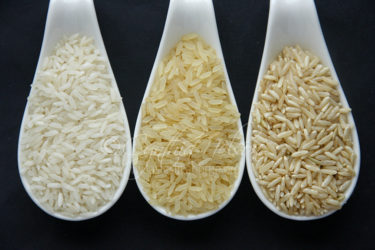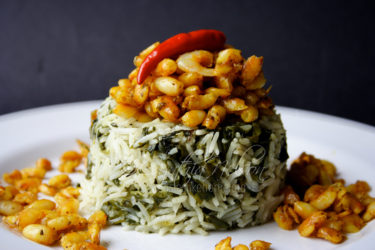What’s Cooking is a series in which I address questions you may have about food and cooking but maybe too shy to ask.
For us, rice is a simple everyday staple in our cuisine. However, rice’s simplicity becomes complex as we determine which cooking technique to apply to the grains. Things can get complicated when we have to cook rice in union with other ingredients that require varying cooking times to create one-pot dishes. But let’s step back from the actual cooking process and discuss how the rice is readied for cooking.
Rinsing
Rinsing or the washing of rice is at once a cultural practice as well as a sometimes-necessary cleansing process. As a cultural practice, it is something that we grew up seeing generations doing as they prepare the rice before adding it to a pot of boiling water, or into empty pots that are then filled with just enough water to cook using the absorption method.

Rice did not always come in the packages we find them in today. It is a commodity that was sold loose from large crocus bags. Some shopkeepers stored the loose rice in drums and barrels from which they would measure and sell. Depending on the quality of the rice, it necessitated “picking” that is, removing stray paddy, brown darkened grains or tiny bits of debris that would have been accidentally scooped up in the filling of the bags. Actually, these days we can still find rice being sold (retail) from crocus bags, particularly at markets. The handling of the rice through the picking process, and the removal of debris, would instinctively lead to the need to further cleanse the rice by washing it in water, several times, until the water runs clear. The washing/rinsing of rice removed particles of dust, not easily seen or removed by hand. This rice-cleansing ritual was also to get rid of the handling of the rice by strangers – prospective customers who would have dug their hands deeply into the bag of rice to toss it and sniff it, to inspect and determine the quality before buying. Today, even though most people buy rice packaged in clear materials where they can see the rice, along with instructions on the package that it is safe to cook the rice directly from the package, we still continue to wash rice before we cook it.
I subscribe to the washing of rice even though it comes nicely and securely packaged. For example, my house rice comes in a plastic bag encased in a cloth bag, stitched tightly to seal and then zipped for added protection. There are two reasons why I wash rice. First, most packaged stuff is done in large factories using machines that are used to sort and pack a variety of items and not exclusively the rice I buy. Actually, if you check on many packages of food items it will say that X, Y or Z was packed in a facility or used a facility that also processes peanuts, dried beans and other grains. This notice is important particularly for people who may have allergies to certain foods. Secondly, I wash rice to get rid of some (not all) of the starch because I want when the rice is cooked, that the grains be separate and not stuck together.
Is it absolutely necessary to wash rice before cooking it? It depends. Take into consideration the source – where you purchase your rice, the packaging, and your personal preference. There are times when we do away with what is normal for us when we follow recipe instructions. For example, when making Italian risotto, it is recommended that the rice not be washed so that while cooking, the starch released, forms the base for the creaminess of the finished dish.
Soaking

(Photo by Cynthia)
The soaking of rice is also a cultural practice we employ though on a very small scale; it is much more prevalent in other parts of the world. The purpose of soaking rice is to soften the grain and shorten the cooking time; it is a process that improves the texture of the rice when cooked.
Not all varieties of rice are suitable for soaking. The grains that take a longer time to cook and need a lot of liquid to cook are perfect for this pre-cooking application. Brown rice and parboiled rice, which are less processed varieties of rice, benefit from soaking. Certain varieties of white rice such as Basmati also benefit from soaking. The rice is soaked in room temperature water after is has been washed/rinsed. There is no exact amount of water required; a general rule of thumb is that the water should at least be 2 inches above the rice. There is a physical change in brown and parboiled rice, after being soaked for at least an hour – the grains lighten in colour and swell due to the intake of water. With Basmati, as the rice takes in water it changes colour, going from being almost translucent to white.
The sturdier rice – brown, parboiled – should be soaked for at least 1 hour and can be soaked for up to 3 hours. Even if they are soaked beyond this time, they still cook up whole with the grains separate. As a guide, soak brown rice for at least 90 minutes, parboiled rice for at least 1 hour and Basmati for at least 30 minutes.
When rice is soaked before cooking, it is always cooked using the steamed/absorption method. The liquid to cook the rice is measured using utensils such as cups or by using the first marking on the index finger to determine the level of water. The finger measuring is done this way – rice and water is added to a pot; the water should come up/measure up to the first mark/joint of the index finger with the tip of the finger resting on top of the rice. The pot is brought to a boil on high heat and then reduced to low and be left to cook in a lidded pot for a specified period of time. Once the time is up, the heat is shut off and the pot is left untouched for a period of time to complete the cooking process. The pot is opened after the resting period and the rice fluffed.
Un-soaked rice cooked using the absorption method requires more water to cook than soaked rice. For example, brown rice would generally take 3 cups of water to 1 cup of rice, when soaked, the rice would need only 2 cups of water. Raw parboiled rice cooks up with 2 cups of water to 1 cup of rice; soaked only 1½ cups of water is needed. Raw Basmati takes 1¾ cups of water to cook, soaked, it needs 1 and 1/3 cups of water. These are general guides, particularly for the brown and parboiled rice. Cooking liquids and times vary by brands. It is important to note that the amount of liquid is determined when the rice is measured before it is soaked, not after. In other words, (based on the guide above) if you are going to soak 2 cups of brown rice, then you will need 4 cups of water to cook the soaked rice. However, if you were not planning to soak the rice, then you will need 6 cups of water to cook the rice.
One-pot rice dishes such as Cook-up rice, Pelau and Rice and peas, all take time to cook and are cooked in union with other ingredients. These types of dishes are best suited to rice that can stand up to long cooking and benefit from soaking; parboiled rice is ideal for these dishes but white rice can be used too sans soaking.
Should you wash rice before cooking it? Should you soak rice before cooking it? It’s really up to you.
Cynthia
cynthia@tasteslikehome.org
www.tasteslikehome.org






